![]()
![]()
![]()
Use LEFT and RIGHT arrow keys to navigate between flashcards;
Use UP and DOWN arrow keys to flip the card;
H to show hint;
A reads text to speech;
51 Cards in this Set
- Front
- Back
- 3rd side (hint)
|
Functions of the Nervous System |
1. Sensory Input 2. Integration 3. Motor output |
|
|
|
Sensory Input |
Imformation gathered by sensory receptors about internal and external changes. |
|
|
|
Integration |
Interpretation of sensory input |
|
|
|
Motor Output |
Activation of effectors organs (muscle and glands) produces a response. |
|
|
|
What are the Divisions of the Nervous System ? |
Central nervous system (CNS) Peripheral nervous system (PNS) |
|
|
|
Central Nervous System (CNS) |
Brain and spinal cord Integration and command center |
|
|
|
Peripheral nervous system (PNS) |
Paired spinal and cranial nerves carry messages to and from the CNS |
|
|
|
What are the two functional divisions for Peripheral Nervous System? |
Sensory (afferent) division Motor (efferent) division |
|
|
|
Sensory: Somatic Afferent Fibers |
Convey impulses from skin, skeletal muscles, and joints. |
|
|
|
Sensory: Visceral afferent fibers |
Convey impulses from visceral organs. |
|
|
|
Motor (efferent) division |
Transmits impulses from the CNS to effector organs. |
|
|
|
What are the two motor division of PNS ? |
Somatic (voluntary) nervous system Autonomic (involuntary) nervous system |
|
|
|
Somatic (voluntary) nervous system |
Conscious control of skeletal muscles. |
|
|
|
Autonomic (involuntary) nervous system |
-Visceral motor nerve fibers. -Regulates smooth muscle, cardiac muscle, and glands. ----> Two functional subdivisions * Sympathetic * Parasympathetic |
|
|
|
Two principal cell types |
Neurons and Neuroglia (glial cells) |
|
|
|
Neurons |
Excitable cells that transmit electrical signals. |
|
|
|
Neuroglia (glial cells)--- supporting cells: |
* Astrocytes (CNS) * Microglia (CNS) * Ependymal cells (CNS) * Oligodendrocytes (CNS) * Satellite cells (PNS) * Schwann cells (PNS) |
|
|
|
Astrocytes |
*Most abundant, versatile, and highly branched glial cells. *Cling to neurons, synaptic endings, and capillaries. * Support and brace neurons. |
|
|
|
Astrocytes |
* Help determine capillary permeability. * Guide migration of young neurons * Control the chemical environment * Participate in information processing in the brain. |
|
|
|
What are the most abundant CNS neuroglia? |
Astrocytes |
|
|
|
Astrocytes are the most abundant CNS neuroglia |
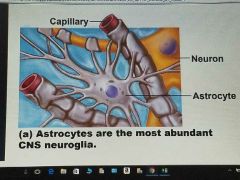
|
|
|
|
Microglia |
* Small, oviod cells with thorny processes * Migrate toward injured neurons * Phagocytize microorganisms and neuronal debris. |
|
|
|
What are the defensive cells in the CNS ? |
Microglial |
|
|
|
Microglial cells are defensive cells in the CNS |
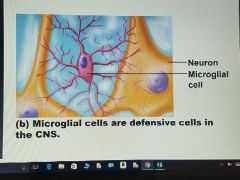
|
|
|
|
Ependymal Cells |
-Range in shape from squamous to columnar. - May be ciliated * Line the central cavities of the brain and spinal column. * Separate the CNS interstitial fluid from the cerebrospinal fluid in the cavities. |
|
|
|
Ependymal cells line cerebrospinal fluid cavities. |
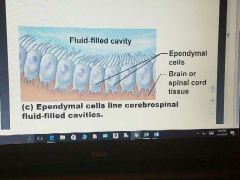
|
|
|
|
Oligodendrocytes have processes that form myelin sheaths around CNS nerve fibers. |
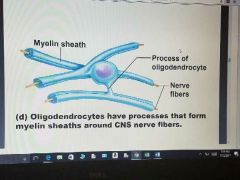
|
|
|
|
Satellite cells and Schwann cells (which form myelin) surround neurons in the PNS. |
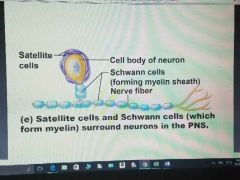
|
|
|
|
Neurons |
^Long-lived ( --> 100 years or more) ^Amitotic --- with few exceptions ^ High metabolic rate --- depends on continuous supply of oxygen and glucose. ^Plasma membrane functions * Electrical signaling * Cell-to-cell interactions during development. |
|
|
|
Cell body (Perikaryon or Soma) |
-Biosynthetic center of neuron -Spherical nucleus with nucleolus -Well-developed Golgi apparatus -Rough ER called Nissl bodies (chromatophilic substance) |
|
|
|
Cell Body (Perikaryon or Soma) cont. |
- Network of neurofibrils (neurofilaments) - Axon hillock ---- cone-shaped area from which axon arises. - Clusters of cell bodies are called nuclei in the CNS, ganglia in the PNS. |
|
|
|
Neuron |
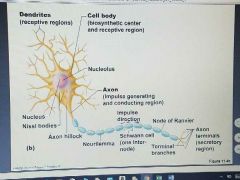
|
|
|
|
Processes |
- Dendrites and axons - Bundles of processes are called * Tracts in the CNS * Nerves in the PNS |
|
|
|
Dendrites |
- Short, tapering, and diffusely branched. - Receptive (input) region of a neuron - Convey eletrical signals toward the cell body as graded potentials. |
|
|
|
Axon |
- One axon per cell arising from the axon hillock. - Long axons (nerve fibers) - Occasional branches (axon collaterals) |
|
|
|
Axon cont. |
- Numerous terminal branches (telodendria) - Knoblike axon terminals (synaptic knobs or boutons) * Secretory region of neuron * Release neurotransmitters to excite or inhibit others cells. |
|
|
|
Axons |
- Conducting region of a neuron - Generates and transmits nerve impulses (action potentials) away from the cell body. |
|
|
|
Neuron |
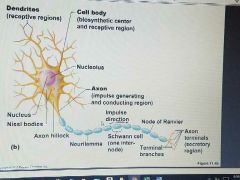
|
|
|
|
Myelin Sheath |
Segmented protein-lipoid sheath around most long or large-diameter axons |
|
|
|
Myelin Sheath it functions to: |
- Protect and electrically insulate the axon. - Increase speed of nerve impulses transmission. |
2 functions |
|
|
Myelin Sheaths in the PNS |
-Schwann cells wraps many times around the axon. * Myelin Sheath ---- concentric layers of Schwann cell membrane. - Neurilemma---- peripheral bulge of Schwann cell cytoplasm. |
|
|
|
Myelin Sheaths in the PNS cont. |
-Nodes of Raniver * Myelin sheath gaps between adjacent Schwann cells. * Sites where axon collaterals can emerge. |
|
|
|
Myelination of a nerve fiber (axon) |
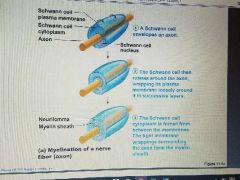
|
|
|
|
Myelination of a nerve fiber (axon) steps: |
1. A Schwann cell envelops an axon. 2. The Schwann cell then rotates around the axon, wrapping its plasma membrane loosely around it in succesive layers. 3. The Schwann cell cytoplasm is forced from between the membranes. |
|
|
|
Unmyelinated Axons |
- Thin nerve fibers are unmyelinated - One Schwann cell may incompletely enclose 15 or more unmyelinated axons. |
|
|
|
Myelin Sheaths in the CNS |
- Formed by processes of Oligodendrocytes, not the whole cell. - Nodes of Ranvier are present. - No nuerilemma - Thinnest fibers are unmyelinated. |
|
|
|
Oligodendrocytes have processes that form myelin sheaths around CNS nerve fibers. |

|
|
|
|
White Matter |
-Dense collections of myelinated fibers. - Mostly neuron cell bodies and unmyelinated fibers. |
|
|
|
Structural Classification of Neurons Three types |
1. Multipolar 2. Bipolar 3. Unipolar ( pseudounipolar) |
|
|
|
Bipolar |
- 1 axon and 1 dendrite - Rare, e.g., retinal nerons |
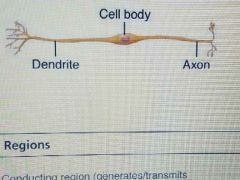
|
|
|
Unipolar (pseudounipolar) |
Single, short process that has two branches: * Peripheral process --- more distal branch, often associated with a sensory receptor. * Central process --- branch entering the CNS. |
|

